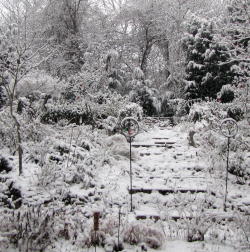
Let us think about wildflowers.

The plant breeders have been especially busy working on the native species of coneflowers. Some are more vigorous than others, Echinacea ‘Sundown’ struggles here but the orangey pink shades are worth finding that perfect spot where it might be happy. We are still working on it.

Echinacea ‘Sunrise’ finds our conditions much more hospitable. Both Sundown and Sunrise are from a cross of E. purpurea and E. paradoxa introduced by Itsaul Plants of Georgia, part of the Big Sky series. The straight species purples and whites are the easiest and most visited by the pollinators however. We have two plants of E. paradoxa started from seed a couple of years ago, still awaiting the yellow blooms on them.

Rudbeckia hirta, Gloriosa daisy pops up in unexpected places, occasionally growing to a nice size.

Lysimachia ciliata ‘Purpurea’ came with a warning when purchased from Mouse Creek Nursery that it could spead aggressively in moist soil. Since we don’t have anything like that on this steep slope, we took a chance on it. It still spreads but is planted in a difficult spot so its habit is welcome. The reddish foliage and glad yellow blooms have won us over.

Asclepias tuberosa ‘Hello Yellow’ attracts many friends both human and insect. Orange, dark and lighter yellows and a reddish orange are all represented in the frontage of the Azalea Walk, formerly known as the hedge bed but since our visit to England the name has been upgraded. Packages of mixed seed and purchased Hellos have filled the space nicely.

Ratibidia columnifera joins the butterfly weed. This dies out after a year or so and attempts at seed sowing have produced no successors so these will be the end of the line here. The plants we have were all mail ordered from High Country Gardens. They are too expensive to keep adding new each year. Too bad, the quirky hat is too cute.

Hemerocallis fulva, H. ‘Pardon Me’, Calamagrostis x acutiflora ‘Karl Foerster’ and Lavandula ‘Provence’ in the foreground are a nice blend in the old gravel driveway bed of the garage, the harshest of growing conditions. Don’t always believe what garden manuals say about what will grow where is the lesson here.

Hyssop officinalis is wrapped in a shawl of Nasella tenuissima, looking quite the coquette. This also seems to struggle here, but new plants are cheap and readily available in the herb section of our local nursuries. Bees love them.

New England Aster, Symphyotrichum novae-angliae is the first of that family to bloom each year in the Fairegarden. Seed plugs from Seed Savers Exchange provided us with pink and blue shades several years ago. They have self sown to the point of weed-dom, almost. A hard cutting back will produce another flush of blooms in the fall.

Veronicastrum virginicum, new to the garden last year joins white astilbe and bronze fennel among others in the yellow/white bed. The candelabra branching will add interest in fall and winter according to the books of Piet Oudolf and Noel Kingsbury. These look promising to fulfill that vision.

Veronicastrum and Mondarda didyma ‘Marshall’s Delight’ in the heather bed also hold promise. This bed is more shady so it remains to be seen how things stand up. Why didn’t we plant all the Veronicastrums together, one might ask? Why indeed, is the answer. We know it is the right thing to do, really, but cannot resist trying things in several places to see how they do first. Or at least that is our alibi. Also, please ignore the ladder. Sheesh.
This fine recognition of deserving natives and wildflowers is all thanks to dear friend Gail of Clay And Limestone on the fourth Wednesday of each month.
Frances









A lovely wildflower parade, Frances. Happy Summer! Nice ladder … I like it and think it photographs very well 🙂
Good morning, So many pretty natives! It’s so much fun to see what’s growing there – some plants like m.’Marshall’s Delight’ and veronicastrum are old friends, others like ratibidia(!) are new and intriguing…I have found all the agastaches, including the rightly praised ‘Blue Fortune’ to be very easy starts from seed, but maybe there’s not room 🙂
I wonder if you might try again, assuming you have full sun for them – I’ve got the acid soil too, and they are reputed to do well in dry heat – my sister in Billings Montana has done very well with them grown from seed. They do seed around so I’ve got lots, and every spring I notice some didn’t make it through winter, possibly because of poor drainage. Why not get a packet or 2 and sow now? They germinate very quickly. Tall blue is tough, I agree, and I’m too cheap to grow delphiniums as annuals:)
So many wild flowers- all so pretty. The Ratibidia looks like a peeled banana! Your garden must be a paradise for all the wild and cultivated flowers:D
Oh my goodness, from your very first to your very last photo, each plant has a twin in my garden, Frances…except I only planted Sunrise and not Sundown. Weedy habit or not, I love them all! Hope you are doing well, haven’t been by in a while. Enjoy your summer! Lynn p.s. love all the daylilies from the last post 😉
I really love how all your plants are packed in together holding each other up. It is wild and airy and colourful. I just think it is perfect.
Frances, Fantastic wildflower post! They are so easy care~except for the ones that won’t survive in our gardens! I have very little luck with the hyssops~No matter which I try…this summer I’ve planted Agastache rupestris (a new one to me) in containers in a mixture of permatill and topsoil. They appear to be thriving and the unusual purple/orange/whatever is rather appealing…It might look good with your black flowers. Veronicastrum joined the gang last year (thanks for the recommendation) and looks promising at C&L. You are so right~ignore the books and try plants. xxgail
A wonderful selection Frances – you really have some beautiful wildflowers. Quite alot of them are sold here though Echinacea Hirta is only an annual here. My wildflower post may be a few days yet for Gail’s meme as I thought I had until next Wed to prepare it!
Frances contact me anytime ref 2011 plans. I think you should be able through wordpress to contact me via this comment otherwise use the “contact me” form at the top of my blog.Look forward to hearing from you. 🙂 Rosie
I’ll take one of each! This is a WONDERFUL post. I like the “THINK” sign, so much…
Your photos show your stunning garden so beautifully.
I forgot about wildflowers on the 4th Wednesday. Yours look great.
Ratibida makes so many good seed heads, try taking a whole one once dry and smushing it into the soil to see if a seedling or two results. It works for me on plants with copious seeds and little success with single seeds. That way some seeds are covered and some not, in case they want light. If you are lucky, a yellow one may come up, too. I cut mine to the ground when they get floppy and they are renewed with vigor.
Hi, Frances; This is such a cool post though I’m surprised to see the same lovely wildflowers in your garden that grow like (pretty) weeds out in my high plains desert! Prairie coneflowers (Ratibidia) speckle the bridle paths around here in late summer. I just love their goofy look. I guess I assumed your plentiful moisture would be hard on them but maybe the I’m the one who’s hard on them. Perhaps they’d appreciate if I turned on the sprinkler! 🙂
Frances, I have had the same disappointing experience with ratibidia. It really is such a shame because it adds such interest. I have also had mixed reviews for the newer echinaceas, and especially for the new coriopsis cultivars. In my humble opinion, the only one (aside from the original tickseed) that does anything around here is good old “Moonbeam.”
Your long-headed cones die out after a year? Hope mine don’t–but I think I have the species, the all yellow, wonder if that matters. And I have that lysimachia in wet clay–it spread about 1-2 feet each year, leaving the center of the clump withut any plants, so I dig up the runners and move them back to the center, thus keeping the spreading vortex ‘o’ lysimachia somewhat in check (but not really). Pretty foliage though.
What a great post! Of course I thought it was the last Wednesday, which is next week. Well, maybe later this year.
I absolutely love the echinacea! And what a lot of great colors. And the Asclepias with bonus butterfly is also wonderful. Ah, it’s all special. I wish I could visit.
Your visions are lovely.
Interesting to see which of the ‘Big Sky’ hybrids do well for you and which languish, Frances. I have no real problems with them other than Twilight, which I find a tad spleeny, but I don’t bother with the Meadowbright series out of Chicago anymore–they refuse to overwinter. Am very pleased to see you growing veronicastrum, which IS an interesting, architecturally pleasing plant. You may find that it gets rather floppy in shade, but does marvelously in sun. I’ve also given up on Ratibida; I think it wants it hotter and drier than my conditions can provide, and perhaps for you it’s the humidity that irks it. Plants is strange critters, sometimes. 🙂
Frances – a very lovely visit through your garden. I sowed seeds of veronicastrum last fall, but the deluges of winter rains washed the seeds somewhere…but, don’t know where. I probably pulled some seedlings, not being familiar with the foliage, thinking they were weeds!
You will love Veronicastrum Frances. I have moved a piece of my original plant (mail ordered) to four different gardens. I now have a huge clump in my front bed and an enormous container of it on my back patio as well. I’ve never thought to let it seed ~ I always deadhead? Wonder why? It would look terrific in winter ~ I think I may follow your lead on that this year. The bees LOVE it here but unfortunately those darn jagged ambush bugs know it and lurk in the stalks. I pick them off daily.
Beautiful echinaceas. I need to move my ‘sunrise’ ~ it’s getting overrun by Joe Pye Weed!
and darn it, I lost my only asclepias this past winter. Now that I’ve seen yours, I need to go in search of a new one…
Good to “see” you again ~ I haven’t been by in awhile. Hope you are off to a good summer?
Your wildflowers are lovely, Frances. I received a ‘Sunset’ echinacea a few weeks ago, so I’m waiting to see how it does here. The hybrids are so tempting, but the common purple coneflowers are still my favorite.
I didn’t even notice the ladder till you mentioned it:)
Love the Veronicastrum virginicum! I bet it would look great amongst umbellifers as well.
I have a packet of E. paradoxa seeds which I didn’t get round to sowing. Shame about the mexican hats
New England aster blooms already?! I also love the Veronicastrum. Wish I had room for it.
So much to study in these shots. I like the way you blended the wild plants into your garden.